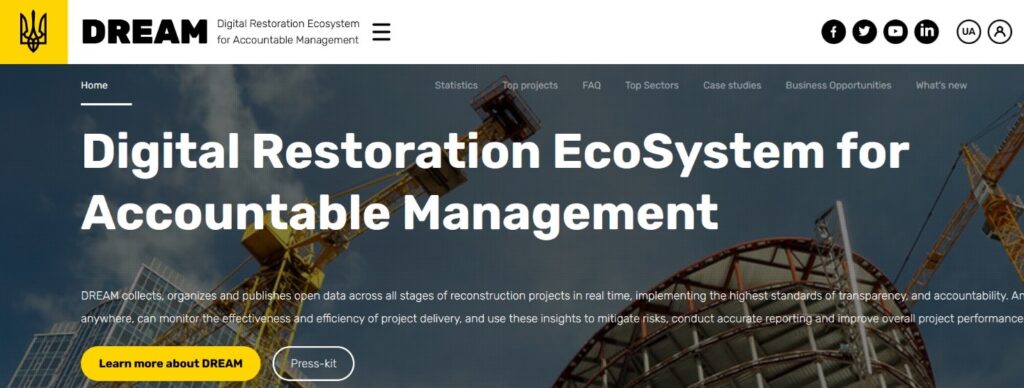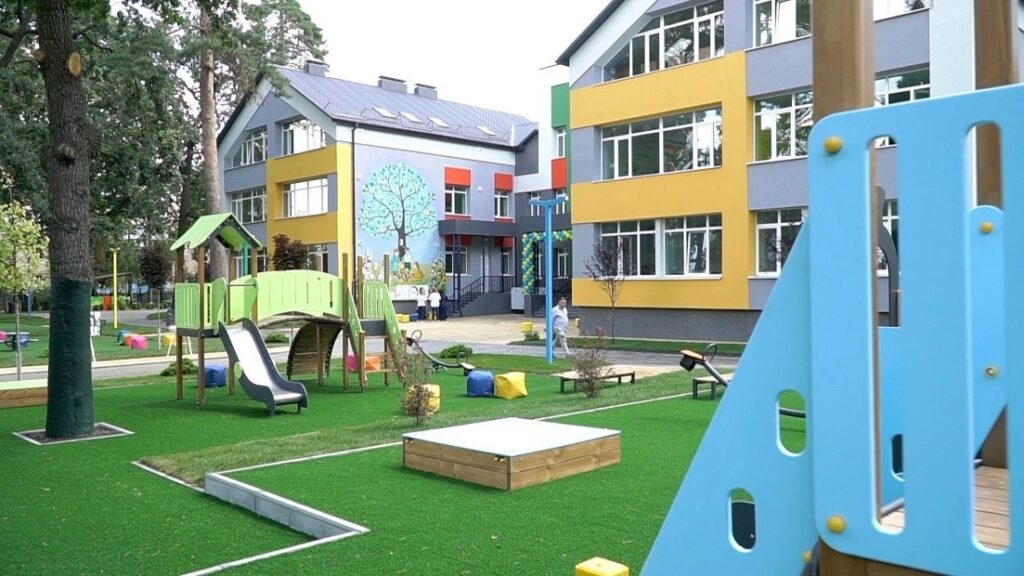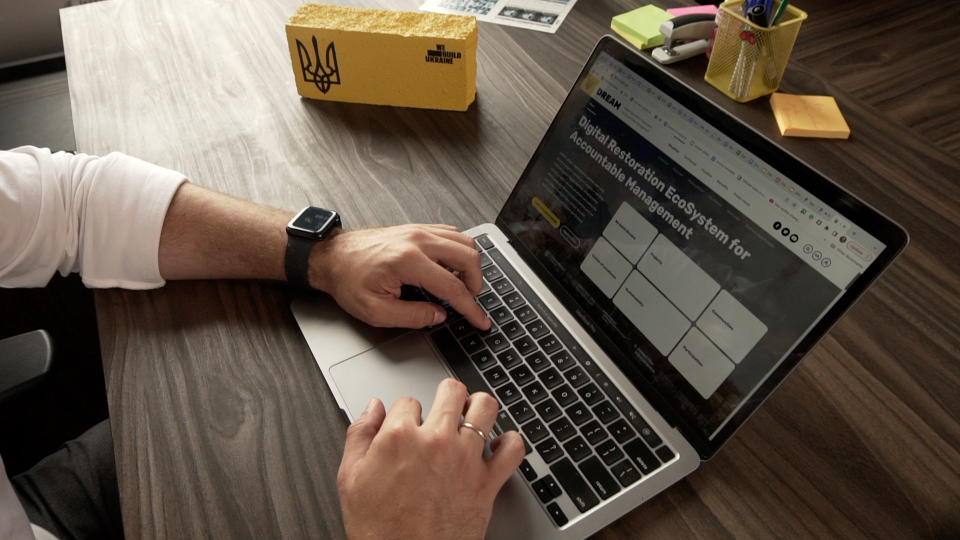International donors should support the Ukrainian DREAM e-system and channel funding for rebuilding Ukraine through it. Dmytro Khutkyy presents this innovative and transparent system in this blog post.
Russia’s war on Ukraine resulted in tremendous damage to Ukraine’s infrastructure estimated to equal USD 151.2 billion as of 1 September 2023. Due to the war, Ukraine’s GDP fell by 29.1% in 2022, and Ukraine’s external fiscal financing gap in 2023 is projected to amount to USD 41.9 billion or approximately 20% of Ukraine’s pre-war GDP. The international community funding Ukraine (including the European Union member states) has expressed concerns about how the aid should be used. Therefore, the Ukrainian government, civil society, and the international community are taking substantial steps to guarantee that public funds for Ukraine’s restoration are used transparently. To ensure that international aid is safeguarded, I recommend that Nordic, Baltic, and other government donor bodies use and fund the DREAM e-system. It has already attracted over a thousand projects and billions of United States dollars of funding, leading almost half of all projects to the active implementation stage.
So, what is the DREAM e-system?
The Digital Restoration EcoSystem for Accountable Management (DREAM) is a state project that creates “a digital route” for all development projects in Ukraine and prioritises transparency at all stages of implementation. Ukraine’s government launched it over a year ago – on 5 March 2023. The e-system’s principal advantage over similar e-systems is that it combines standardised profiling and procedural formats with a decentralised approach to managing national and international aid and investment. Local communities present their needs, residents prioritise restoration objects, the e-system ranks objects according to the RISE Ukraine – Coalition for Reconstruction and the World Bank methodology, and in the end, Ukrainian authorities and international partners match their funding with relevant cases, resulting in synergy projects. DREAM is synchronised with the existing Ukrainian public information systems, including the award-winning Prozorro public procurement e-system. Each restoration project registered in DREAM has its information published in open data format and accessible via API for straightforward civic oversight.
The DREAM e-system is an innovative project being tested and developed by the Ministry for Communities, Territories and Infrastructure Development of Ukraine. Its full version will include investment profiles of governing bodies, sector profiles, profiles of the financial partners of the restoration, an open data and analytics module, risk management systems for different user groups, a user competence centre, e-democracy tools, and become a multi-donor coordination platform. However, these components are not set in stone, and there is room for development as new modules are added.
Overall, the DREAM design can be summarised as “a state digital ecosystem that provides a single digital pipeline for all reconstruction projects.” According to the e-system website, in DREAM communities have the opportunity to present projects to international partners in order to receive resources and subsequently undertake the construction process. This kind of ecosystem would allow for the highest form of transparency in Ukraine’s recovery. This is because real trust is formed between all stakeholders involved: the government, citizens, businesses, and financial institutions.

Image 1. DREAM webpage. Source: DREAM.
Intensive restoration underway
Despite the ongoing Russia-Ukraine war, Ukraine’s restoration is already in full swing. As the publicly available statistics module DREAM Analytics reads, as of 3 December 2023, the e-system included a total of 1437 projects with an overall estimated budget of over UAH 64.14 billion, of which over UAH 41.99 billion funding is confirmed, resulting in 65% of financial coverage. Considering the risks of further destruction and unpredictable funding, coverage of around two-thirds of reconstruction needs is promising. Since recovery first requires the restoration of basic facilities and services to satisfy the immediate needs of locals, most projects (1151 or over 80%) fall under the restoration category, and only 325 or less than 20% are aimed at development. Of all the projects, 697 or over 47% are active.
Regionally, the largest number of projects are located in the Kyiv and Kharkiv regions – 420 and 173, respectively. These areas suffered from severe destruction following Russia’s invasion in the spring of 2022 but were liberated by Ukraine in the autumn of that year. Furthermore, both areas have been under Ukraine’s control for over a year. Yet, the third most project-numerous region is Lviv Oblast, with 110 projects. Although the Lviv region was not the frontline, it suffered from the shelling of critical infrastructure and other objects.
The project’s shining example
There are already successful cases of organising restoration using the DREAM platform. One example is the Ruta kindergarten in Irpin, Kyiv region. Before the full-scale invasion, the kindergarten was one of the largest in the community, with about 400 children and 65 employees. As a result of the repeated shelling, explosions, and fire, the facility was almost totally destroyed. After the de-occupation of Irpin, delegations from the Republic of Lithuania visited the town and were shocked by the consequences of the aggression. They, therefore, offered to help restore the kindergarten.
Within just a year, the kindergarten has been transformed into a state-of-the-art educational institution that adheres to safety and inclusivity standards. To ensure the safety of children and employees, the kindergarten now has a basement-located shelter with modern ventilation and warning systems, bathrooms, recreation areas, and toys for the children. As a tribute to the Lithuanian support, the institution was renamed Ruta, which is symbolic in Ukrainian and Lithuanian mythology and has the same meaning and sound in both languages. Moreover, the exterior design of the kindergarten features the colours of the Ukrainian and Lithuanian flags. The rebuilt kindergarten was opened before the school year, on 24 August 2023, precisely on Ukraine’s Independence Day.

Image 2. The restored Ruta kindergarten in Irpin, Kyiv region. Source: DREAM.
Citizen engagement for recovery
Notably, the DREAM platform is not merely a top-down bureaucratic procedure. It actually has the capacity to channel the grass-roots participation of everyday citizens. This is envisioned in the DREAM system’s Electronic Democracy Module (eDem). This in-development module aims to identify effective mechanisms for transparent and democratic involvement of all interested parties in restoration projects in order to increase the level of trust and support among Ukrainians and international partners. To achieve this, the module has put forward seven diverse tasks, with activities ranging from the engagement of citizens to the exchange of best practices.
While this may sound ambitious, it is feasible. The project relies on the capacities of Ukraine’s Ministry of Infrastructure, USAID, PACT, the Centre for Innovations Development, and RISE Ukraine. Moreover, in the spirit of inclusive public engagement, DREAM contains an open call for DREAM eDem expert network members. In practice, in 2023 the multistakeholder expert network conducted several citizen engagement surveys and discussions, as well as launched the modelling of business processes for civic e-participation in the country’s restoration.
DREAM is not without challenges
However well-designed, the e-system faces one central issue: the usage scale. This is because DREAM is a pilot and optional project. Hence, Ukrainian communities join it voluntarily, and the e-system covers only a part of the country’s recovery and reconstruction initiatives. Therefore, in the short term, DREAM requires promotion among both Ukrainian communities and foreign donors. In the long term, the government plans to make the DREAM e-system mandatory for all restoration projects in Ukraine.
From fantasy to feasibility
The DREAM initiative has all the preconditions of becoming successful. It addresses Ukraine’s urgent need to rebuild damaged and destroyed infrastructure. It is mandated by the Ministry for Communities, Territories and Infrastructure Development of Ukraine, and funded by the UK International Development, GIZ, USAID, UKAID, and Eurasia Foundation. It is supported by several partners including the Open Contracting Partnership, RISE Ukraine, BRDO, Transparency International Ukraine, BHP Foundation, Spilno, and Opendatabot.
Moreover, the partners rely on similar initiatives implemented before. These include Prozorro (a robust, open, hybrid system of electronic public procurement), Dozorro (an online civic oversight of public procurement), and Prozorro.Sale (a state online e-auction system for selling and leasing government and municipal property in a fair, transparent way). These received international recognition: Prozorro won the 2016 Open Government Award, Dozorro was acknowledged in 2018 as an OGP star reform, and Prozorro.Sale received the 2021 OGP Impact Award.
DREAM is the reality of Ukraine’s restoration
The DREAM platform is not just a dream; it’s a reality. Driven by the pressing need to rebuild Ukraine – and guided by the principles of transparency, participation, and accountability – on 5 March 2023 a multistakeholder partnership of governments, international institutions, and civil society organisations has launched an online platform for managing the country’s restoration. Indeed, it has already attracted over a thousand projects and billions of United States dollars of funding, leading almost half of all projects to the active implementation stage. Considering the innovative design, the parties involved, and the results achieved so far, the platform appears to be a promising endeavour in ensuring a transparent restoration of Ukraine’s infrastructure. Nordic, Baltic and other donors should direct international financial aid via the DREAM e-system and support it by becoming funders, thereby continuing to walk alongside Ukraine on the road to restoration.
Pictures: Creative Commons Attribution-NonCommercial-ShareAlike 4.0 license.


